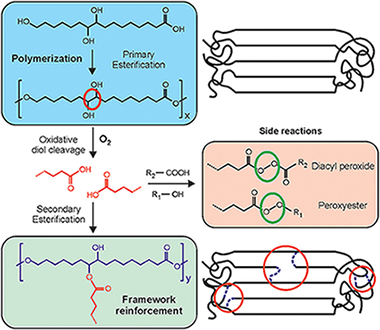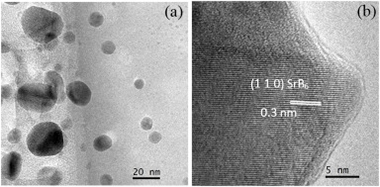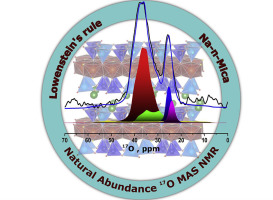Scientific Papers in SCI
2019
2019
Materiales de Diseño para la Energía y Medioambiente
Insoluble and Thermostable Polyhydroxyesters From a Renewable Natural Occurring Polyhydroxylated Fatty Acid
Benitez, JJ; Guzman-Puyol, S; Cruz-Carrillo, MA; Ceseracciu, L; Moreno, AG; Heredia, A; Heredia-Guerrero, JAFrontiers in Chemistry, 7 (2019) art. 643
Show abstract ▽

To explore the potential of long chain polyhydroxyalkanoates as non-toxic food packaging materials, the characterization of polyesters prepared from a natural occurring polyhydroxylated C16 carboxylic acid (9,10,16-trihydroxyhexadecanoic or aleuritic acid) has been addressed. Such monomer has been selected to elucidate the reactivity of primary and secondary hydroxyl groups and their contribution to the structure and properties of the polyester. Resulting polyaleuritate films have been produced using an open mold in one-step, solvent-free self-polycondensation in melt state and directly in air to evaluate the effect of oxygen in their final physical and chemical properties. These polymers are amorphous, insoluble, and thermostable, being therefore suitable for solvent, and heat resistant barrier materials. Structurally, most of primary hydroxyls are involved in ester bonds, but there is some branching arising from the partial participation of secondary O-H groups. The oxidative cleavage of the vicinal diol moiety and a subsequent secondary esterification had a noticeable effect on the amorphization and stiffening of the polyester by branching and densification of the ester bond network. A derivation of such structural modification was the surface compaction and the reduction of permeability to water molecules. The addition of Ti(OiPr)(4) as a catalyst had a moderate effect, likely because of a poor diffusion within the melt, but noticeably accelerated both the secondary esterification and the oxidative processes. Primary esterification was a high conversion bulk reaction while oxidation and secondary esterification was restricted to nearby regions of the air exposed side of cast films. The reason was a progressive hindering of oxygen diffusion as the reaction progresses and a self-regulation of the altered layer growth. Despite such a reduced extent, the oxidized layer noticeably increased the UV-vis light blockage capacity. In general, characterized physical properties suggest a high potential of these polyaleuritate polyesters as food preserving materials.
September, 2019 | DOI: 10.3389/fchem.2019.00643
Química de Superficies y Catálisis
Montmorillonite-stabilized gold nanoparticles for nitrophenol reduction
Chenouf, M; Megias-Sayago, C; Ammari, F; Ivanova, S; Centeno, MA; Odriozola, JAComptes Rendus Chimie, 22 (2019) 621-627
Show abstract ▽
Two gold-based catalysts were obtained by Au chemical reduction of the HAuCl(4 )precursor. The resulting nanoparticles were stabilized and immobilized on montmorillonite (Mt) and montmorillonite-ceria (Mt/CeO2). All prepared catalysts were active in 4-nitrophenol to aminophenol reduction at room temperature. Synergy between montmorillonite and ceria is postulated in such a way that the montmorillonite phase hinders particle growth either by influencing the nucleation behavior of gold or by increasing the number of nucleation sites and raising the overall dispersion. The role of the ceria support, on the other hand, may be associated with the 4-NP adsorption at the ceria-gold interface, stabilizing the reaction intermediate and hence lowering the activation barrier for the reduction of 4-NP to 4-AP.
September, 2019 | DOI: 10.1016/j.crci.2019.07.005
Reactividad de Sólidos
Mechanically induced combustion synthesis and thermoelectric properties of nanostructured strontium hexaboride (SrB6)
Jalaly, M; Khosroshahi, BK; Gotor, FJ; Sayagues, MJ; Yamini, SA; Failamani, F; Mori, TCeramics International, 45 (2019) 14426-14431
Show abstract ▽

The nanoparticles of strontium hexaboride (SrB6) were synthesized by a mechanically induced magnesiothermic combustion in the Mg/B2O3/SrO system. Ignition time in this system was recorded to be 23 min of milling. X-ray diffraction(XRD), X-ray photoelectron spectroscopy (XPS), and high-resolution transmission electron microscopy (HRTEM) techniques were used to characterize the combustion product. Thermal analysis was employed to assess the formation mechanism. It was revealed that Mg initially reduced B2O3 in a combustive manner to generate elemental boron and a large amount of heat, resulting in the reduction of SrO by Mg at high temperature. The in-situ formed elemental Sr and B react immediately to generate SrB6. Thermoelectric properties of consolidated SrB6, including thermal conductivity, Seebeck coefficient, electrical conductivity, and figure-of-merit were evaluated at the temperature range of 300–873 K.
August, 2019 | DOI: 10.1016/j.ceramint.2019.04.163
Materiales Coloidales
Luminescence and X-ray Absorption Properties of Uniform Eu3+:(H3O)Lu3F10 Nanoprobes
Gonzalez-Mancebo, D; Becerro, AI; Corral, A; Balcerzyk, M; Ocana, MNanomaterials, 9 (2019) 1153
Show abstract ▽

Due to the high atomic number of lutetium and the low phonon energy of the fluoride matrix, Lu-based fluoride nanoparticles doped with active lanthanide ions are potential candidates as bioprobes in both X-ray computed tomography and luminescent imaging. This paper shows a method for the fabrication of uniform, water-dispersible Eu3+:(H3O)Lu3F10 nanoparticles doped with different Eu contents. Their luminescent properties were studied by means of excitation and emission spectra as well as decay curves. The X-ray attenuation capacity of the phosphor showing the highest emission intensity was subsequently analyzed and compared with a commercial contrast agent. The results indicated that the 10% Eu3+-doped (H3O)Lu3F10 nanoparticles fabricated with the proposed polyol-based method are good candidates to be used as dual probes for luminescent imaging and X-ray computed tomography.
August, 2019 | DOI: 10.3390/nano9081153
Materiales de Diseño para la Energía y Medioambiente
Natural abundance O-17 MAS NMR and DFT simulations: New insights into the atomic structure of designed micas
Pavon, E; Osuna, FJ; Alba, MD; Delevoye, LSolid State Nuclear Magnetic Resonance, 100 (2019) 45-51
Show abstract ▽

Combining O-17 Magic-Angle Spinning (MAS) NMR at natural abundance with DFT calculations is a promising methodology to shed light on the structure and disorder in tetrahedral sheets of designed micas with enhanced properties. Among brittle micas, synthetic mica is an important alternative to natural ones with a swelling sheet-like structure that results in many applications, by exploiting unique characteristics. Lowenstein's rule is one of the main chemical factor that determines the atomic structure of aluminosilicates and furthermore their properties. In the present article, O-17 MAS NMR spectroscopy is used to validate (or not) the agreement of the Lowenstein's rule with the distribution of Si and Al sites in the tetrahedral sheets of synthetic micas. O-17 MAS spectra of synthetic high-charged micas exhibit two regions of signals that revealed two distinguishable oxygen environments, namely Si-O-X (with X = Si, Al-tet , Mg) and Al-tet -O-Y (Y=Mg or Al-tet). DFT calculations were also conducted to obtain the O-17 chemical shift and other NMR features like the quadrupolar coupling constant, C-Q, for all of the oxygen environments encountered in the two model structures, one respecting the Lowenstein's rule and the other involving Al-tet -O-Al-tet and Si-O-Si environments. Our DFT calculations support the O-17 assignment, by confirming that Al-tet -O-3Mg and Al tet -O-Al tet oxygen environments show chemical shifts under 30 ppm and more important, with quadrupolar coupling constants of about 1 MHz, in line with the spectral observation. By quantifying the O-17 MAS NMR spectra at natural abundance, we demonstrate that one of the synthetic mica compositions does not meet the Lowenstein's rule.
August, 2019 | DOI: 10.1016/j.ssnmr.2019.03.006
- ‹ previous
- 118 of 410
- next ›














